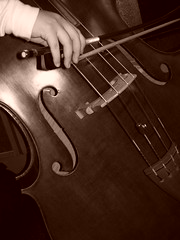 Photo taken at Esplanade - Theatres on the Bay, in Mar 2006.
Photo taken at Esplanade - Theatres on the Bay, in Mar 2006.Some learning points are useful and worth sharing, so I shall post some of these here. To do so, I shall let time unwind to
13 Dec 2006 (Wed):
That day, our double bass quartet was scheduled to have our very first rehearsal after a more-than-one-month break.
As one of the players from our quartet, XM, could not be present yesterday, we had the honour to have our tutor stand in for XM and play with us for the sectionals. I remember that Emily was impressed that our tutor could play and listen to each and every one of us at the same time. In addition, our tutor has to guide us to play as an ensemble.
Our dear tutor gave us helpful tips on how we could practise for the double bass ensemble. Here are some that I have listed down from whatever I had remembered:
1) Practise the accompaniment with the part playing the bass first. The bow strokes and articulation of the accompaniment should be the same. The strokes should be short, light, and clear. The bassline could be louder. The middle parts should generally play light strokes. After the accompaniment and bass are playing satisfactorily, add the solo (melody).
2) Observe the dynamic changes.
3) For works that involve synocopation, practise each section, part by part.
4) Players playing the melody and counter-melody parts should find time to practise with each other and learn to play as an ensemble, without the accompaniment.
The tips may seem simple, yet they require diligence and discipline to practise.




